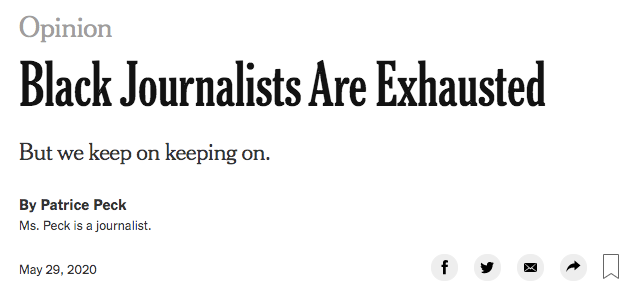Defector Capitalism: an existential threat to “the firm”
On Stakeholder Capitalism, Ziwe, and the decentralized autonomous organization
Almost a year ago, on October 30, 2019, the entire staff of sports outlet Deadspin quit. That day marked six months since the acquisition of Deadspin’s parent company Gizmodo Media Group (now named G/O Media) by Great Hill Partners, a private equity firm. It also marked two months since the Deadspin staff published a scathing condemnation of Great Hill Partners and the new CEO it had put in place. The piece, among other things, criticized the firm’s “lack of communication regarding company goals, seeming disregard for promoting diversity within the top ranks of the company, and … repeated and egregious interference with editorial procedures.”
This past July, Defector Media was born. 19 former Deadspin employees formed this new media outlet, whose content would echo that which they produced prior to Gizmodo’s acquisition. What is perhaps most notable about Defector is it’s structure. The company:
Is completely owned by the employees and has no outside investors. Each employee owns a 5% stake.
Will rely completely upon subscriptions to compensate each employee/owner. There will be no advertising.
Grants ownership of all intellectual property, as well as management and editorial control, to the employee/owners.
Allows the employee/owners to remove the Editor in Chief with a ⅔ majority vote.
Defector recently hit 30,000 paying subscribers, which should at minimum equate to $2.5MM in annual revenue. Deadspin, on the other hand, remains alive but is suffering from diminished traffic, engagement, and influence. [1]
The Deadspin/Defector story is just one of many demonstrating what is becoming an overwhelming trend: corporate employees, frustrated with a dispassionate and disconnected executive board or corporate strategy, are exiting to build their own mini-empires. They are making this happen either independently or in the form of a co-operative, organized with like-minded talent over the Internet.
Substack, for example, has taken off in the time of coronavirus. Readership and active writers on this platform for newsletter creation has doubled between January and April of this year. [2] Many Substack writers are telling stories which they would not be able to tell within the walls of traditional outlets. Writers like Patrice Peck, who previously wrote at Buzzfeed, founded Coronavirus News for Black Folks to fill a gap within mainstream news media regarding the disproportionate impact of the pandemic on the Black community. Shortly following its launch, her newsletter received coverage across a number of traditional outlets including the New York Times.
So, writers and journalists no longer need publishers or traditional distribution channels to tell their stories. In fact, breaking from those outlets may be the only way to get their stories heard in the first place.
We’ve seen this trend in video as well. The COVID-19 quarantine has shot Instagram live TV shows like Serena Kerrigan’s Let’s F*cking Date and Ziwe Fumudoh’s Baited into the realms of pop culture. Both shows were created and produced entirely by the creator to convey a message not being expressed on mainstream TV or even second wave production companies and distributors like Netflix. Yet both have found success. Following the success of Season 1, Kerrigan has already sold out sponsorships for and hired a team to produce Season 2. Fumudoh got a book deal. [3]
After having spent the past few years researching and investing in decentralized networks, I can’t help but notice the striking similarities between these ongoing shifts in media production and trends occurring across tech and finance. The technology and financial services stack as we know it are being decentralized. Hundreds of thousands of individual actors and loosely organized digital organizations around the world are contributing their time, resources, and hardware to bootstrapping the world’s next wave of infrastructure (in return for some protocol-defined compensation, of course). Layers of the stack include networks for file storage (I.e. Filecoin), video live-streaming (I.e. Livepeer), and data index (I.e. The Graph). And more than $11B of assets have been locked in a financial application layer built on top of that underlying infrastructure.
None of these services are operated by an Amazon- or JPMorgan-like entity, with a Board or shareholders to report back to. Rather, these networks are operated by a massive set of owner/contributors who have earned the right to opine and vote on the direction of the network. The networks are kept “alive” and functioning by these owner/contributors and by third party developers who might receive grants approved by them.
Many of these networks are in fact controlled by “decentralized autonomous organizations”, or DAOs, with rules that look very similar to those of Defector Media. Compound, a lending and borrowing facility, is a great example. The protocol:
Is completely owned and managed by the holders of a digital asset called COMP. I will refer to these COMP-holders as the Compound owner/contributors.
Contributors to the protocol - borrowers and lenders - will receive the COMP asset in return for their proportional usage over the next 4 years. (Previous institutional investors and the primary Compound development team, among others, also receive an allocation.)
Owner/contributors propose, debate, and vote on changes to the protocol. 1 COMP = 1 vote.
While there is no set payout to owner/contributors today, I expect that they will vote in some form of compensation to the protocol in the future. [4]
Why did we ever need massive corporations in the first place? Ronald Coase’s Nature of the Firm posits that the firm is a response to the high transaction cost of obtaining goods and services from the market. If it’s cheaper to hire people and conduct an activity in-house than to negotiate contracts with external parties to obtain a desired outcome, then do it in-house.
However, over the past decade, technology has drastically reduced transaction costs. The entrepreneur’s tech stack (social media broadly, Mailchimp, Squarespace, etc.) has made it easier to DIY the administrative and marketing activities of a small business while the emergent blockchain-enabled tech stack has minimized the trust required to interact and exchange value on Internet. It has never been easier to transact efficiently with the market as a singular or relatively small entity to achieve a goal -- it has never been easier for frustrated employees to defect and do it their way.
These trends arise amidst a growing battle between shareholder and stakeholder capitalism. The former abides by Milton Friedman’s proclamation that the purpose of the firm is to increase its profits. The latter takes an all-inclusive view: businesses should act to enhance the well-being of not only their shareholders but also their employees, customers, suppliers, the environment, and so on. While many Fortune 500s have made lofty statements regarding their commitments to stakeholders, the public remains skeptical. [5]
Younger generations in particular have become frustrated with the corporate status quo. A recent article in the New York Times highlighted a group of teenage developers who have built their own Discord channel, Gen Z Mafia, focused on building “a more positive internet, things that help people”. They see this as a “counterpoint to the Silicon Valley establishment, which its members say is exclusive, elitist and riddled with systemic problems including sexism, ageism and racism.”
It’s possible that this combination of frustration with the corporate status quo with a host of new technologies and frameworks might entirely rework our means of economic value creation in the years to come. The evolution of these two trends together may be difficult to predict. What is clear, however, is that the opportunities available to defectors have never been greater.
~~~
Photo credits: Defector.com, The New York Times, @ziwe, Defipulse, Compound Governance Portal, Wall Street Journal, The New York Times, Twitter
[1] The New Republic. Is Defector the Future of Media? Alex Shephard.
[2] a16z podcast. So You Want to Launch a Newsletter -- Tips from Writers. Patrice Peck, Lenny Rachitsky, Edith Zimmerman, Zach Haigney, and Lauren Murrow.
[3] Vervuz is another great example of an Instagram live TV show which took off during the COVID-19 quarantine period. A recent episode featuring Brandy and Monica became the most watched livestream webcast ever with over 1.2M concurrent views, according to Entertainment Weekly. I excluded Vervuz from my post because its creators, producers Timbaland and Swizz Beats, started out with a leg up in starting capital and connections over Kerrigan and Fumudoh.
[4] Compound Medium Blog. Expanding Compound Governance. Robert Leshner.
[5] Wall Street Journal. Stakeholder Capitalism Seems Mostly for Show. Lucian Bebchuk and Roberto Tallarita; The New York Times. Shareholder Value is No Longer Everything, Top C.E.O.s Say. David Gelles and David Yaffe-Bellany.








Great points. Incredibly well researched